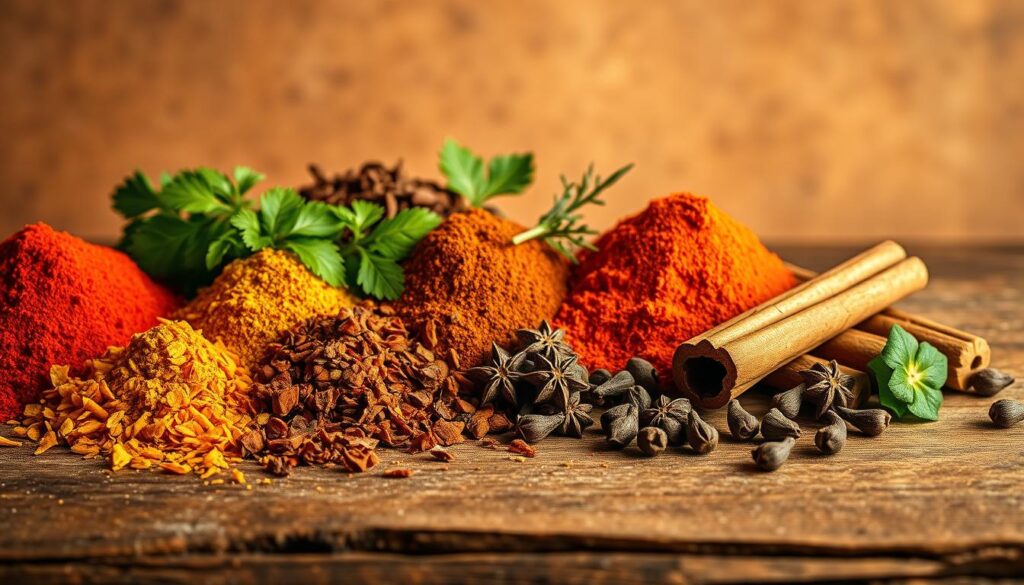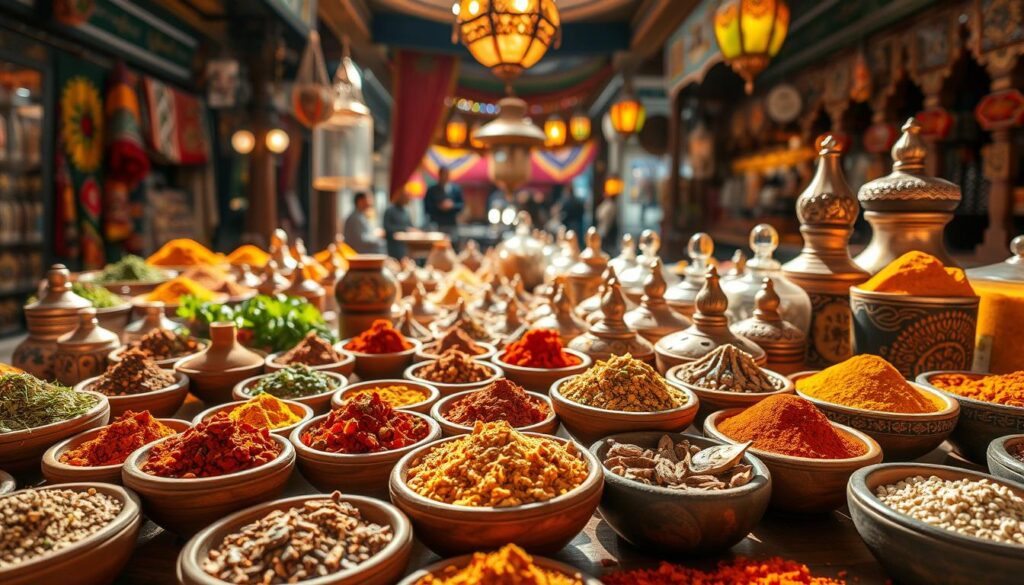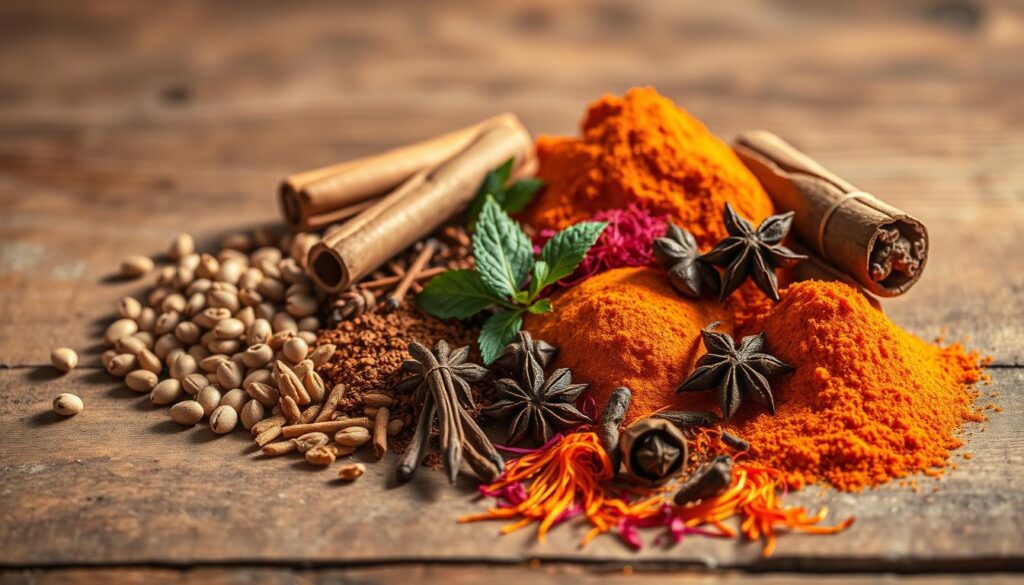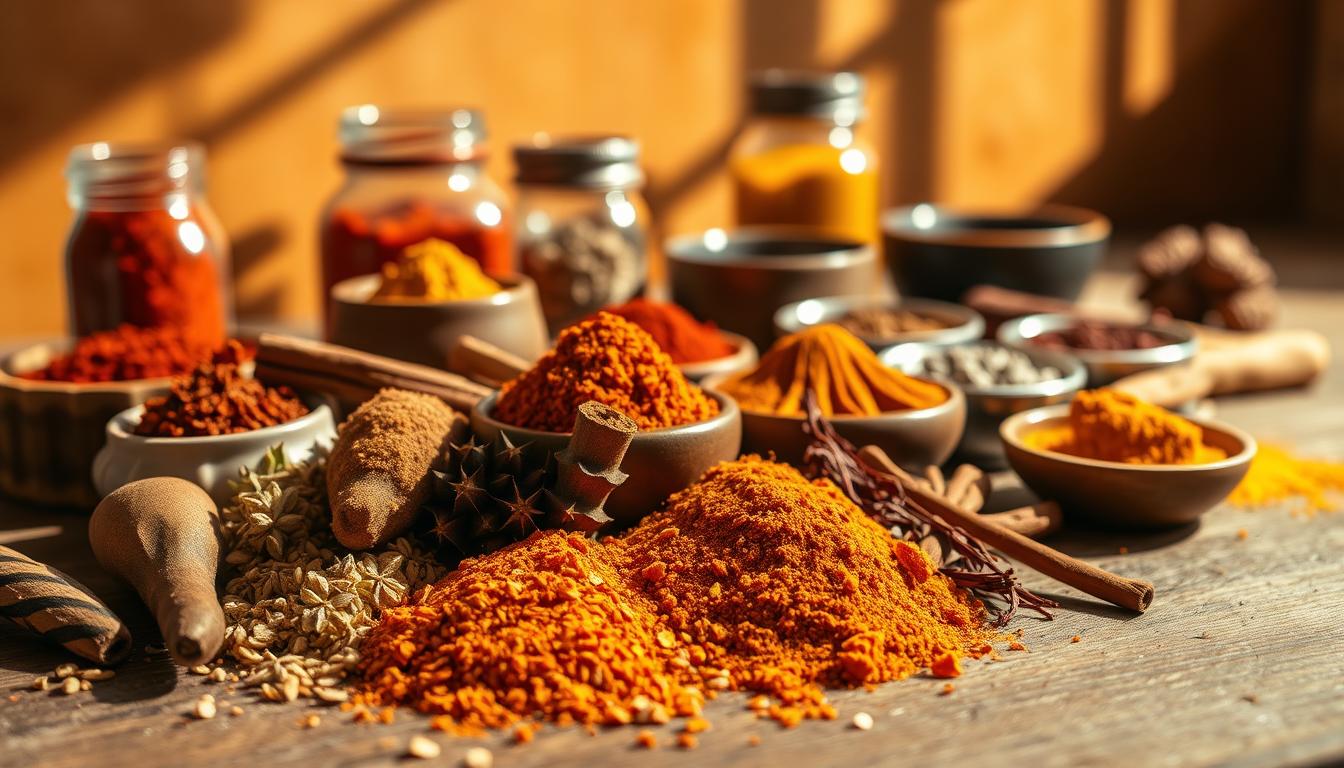Are you ready to unlock the secrets of Moroccan cuisine and take your cooking to the next level? Moroccan dishes are renowned for their rich and complex flavors, which are achieved through the use of a diverse array of aromatic spices.
The right blend of spices can transform a simple meal into a culinary masterpiece. In this article, we will explore the essential Moroccan cooking spices that will elevate your dishes and provide you with the knowledge to create authentic Moroccan flavors.
Key Takeaways
- Discover the most important spices used in Moroccan cooking
- Learn how to blend spices to create authentic Moroccan flavors
- Understand the role of spices in elevating your dishes
- Get tips on using Moroccan spices effectively in your cooking
- Explore the versatility of Moroccan spices in various recipes
Introduction to Moroccan Spices
The vibrant world of Moroccan spices is a fascinating blend of cultures and traditions. For centuries, authentic Moroccan spices have played a pivotal role in shaping the country’s culinary identity. The rich flavors and aromas of Moroccan cuisine are largely attributed to the diverse and aromatic traditional Moroccan seasonings used in its preparation.
The Rich History of Moroccan Cuisine
Moroccan cuisine has a rich history that has been influenced by various cultures, including Arab, Mediterranean, and African. The use of traditional Moroccan seasonings dates back centuries, with spices being traded and adopted from different parts of the world. This cultural exchange has contributed to the unique flavor profiles characteristic of Moroccan dishes.
The significance of spices in Moroccan cuisine cannot be overstated. They are not just used to add flavor but also to preserve food, especially in the absence of modern refrigeration techniques. The careful selection and blending of authentic Moroccan spices have been passed down through generations, with each family having their own secret recipes.
How Spices Define Moroccan Dishes
Traditional Moroccan seasonings are the backbone of Moroccan cooking. Spices such as cumin, coriander, and paprika are staples in every Moroccan kitchen. These spices are used to create complex and aromatic flavor profiles that are characteristic of Moroccan cuisine.
- Cumin adds a warm, earthy flavor to dishes like tagines and stews.
- Coriander provides a citrusy and slightly sweet note, often used in conjunction with cumin.
- Paprika contributes a smoky depth to various Moroccan recipes.
The art of blending authentic Moroccan spices is a skill that has been honed over centuries. The proportions of each spice can vary greatly depending on the dish being prepared and the personal preference of the cook. This blend of spices is what gives Moroccan cuisine its distinctive taste and aroma.
Essential Spices for Moroccan Cooking
At the heart of Moroccan culinary tradition are a few essential spices that elevate dishes with their unique flavors and aromas. These spices not only add depth but also define the characteristic taste profiles of various Moroccan dishes.
Cumin: The Backbone of Flavor
Cumin is one of the most commonly used spices in Moroccan cooking, providing a warm, earthy flavor that is fundamental to many dishes. It is often used in combination with other spices to create complex flavor profiles.
Usage Tip: Toasting cumin seeds before grinding them can enhance their flavor, adding a nuttier and more aromatic quality to your dishes.
Coriander: A Citrus Burst
Coriander, the seed of the cilantro plant, offers a citrusy and slightly sweet flavor that complements the earthiness of cumin. It is a versatile spice used in a variety of Moroccan recipes.
Pairing Idea: Coriander pairs well with ingredients like chicken and vegetables, especially when used in tagines and stews.
Paprika: Sweet and Smoky Delights
Paprika adds a sweet and smoky dimension to Moroccan dishes, ranging from mild to hot depending on the type used. It is a key ingredient in many spice blends and is used to add color and flavor to dishes.
Variety Tip: Sweet paprika is often used for its color and mild flavor, while smoked paprika can add a deep, smoky flavor to dishes like stews and grilled meats.

| Spice | Flavor Profile | Common Uses |
|---|---|---|
| Cumin | Warm, Earthy | Tagines, Stews, Spice Blends |
| Coriander | Citrusy, Slightly Sweet | Tagines, Marinades, Vegetable Dishes |
| Paprika | Sweet, Smoky | Stews, Grilled Meats, Spice Blends |
Unique Flavors: The Signature Spices
The essence of Moroccan cooking lies in its signature spices, which add depth and complexity to a variety of traditional dishes. These spices are not just additives; they are the heart and soul of Moroccan cuisine, defining its rich and diverse flavor profiles.
Ras el Hanout: The Spice Mix of Morocco
Ras el Hanout, which translates to “head of the shop,” is a blend of spices that can vary significantly from one vendor to another. It’s a complex mix that typically includes over 30 different spices, including cumin, coriander, cinnamon, and cardamom. This blend is crucial for authentic Moroccan flavor, used in a variety of dishes from tagines to couscous.
Saffron: The Gold Standard in Flavor
Saffron, known for its vibrant color and distinct flavor, is considered the gold standard in Moroccan cuisine. It’s used sparingly due to its high cost, but it adds a unique aromatic quality to dishes like paella and certain tagines. Saffron is a key ingredient that elevates the flavor profile of Moroccan dishes, making them truly distinctive.
Harissa: A Fiery Chili Paste
Harissa is a chili paste that adds a spicy kick to Moroccan dishes. Made from roasted red peppers, garlic, and spices, it’s a versatile ingredient used in everything from soups to marinades. Harissa’s flavor is both spicy and slightly smoky, adding a layer of complexity to Moroccan cooking.
| Spice | Description | Common Uses |
|---|---|---|
| Ras el Hanout | A complex blend of over 30 spices | Tagines, couscous, meat dishes |
| Saffron | Known for its vibrant color and distinct flavor | Paella, certain tagines, luxurious dishes |
| Harissa | A spicy chili paste with a smoky flavor | Soups, marinades, adding heat to dishes |
The Role of Herbs in Moroccan Cuisine
Herbs play a pivotal role in Moroccan cuisine, bringing a burst of freshness and aroma to traditional dishes. The use of fresh herbs is a hallmark of traditional Moroccan seasonings, elevating the flavors of various recipes.

Fresh Cilantro: Aromatic and Refreshing
Fresh cilantro is a staple herb in Moroccan cooking, known for its aromatic and refreshing qualities. It is often used as a garnish or added towards the end of cooking to preserve its flavor and texture.
Cilantro pairs well with a variety of ingredients, including meats, vegetables, and grains, making it a versatile addition to many dishes.
Mint: A Sweet Addition
Mint is another herb that is widely used in Moroccan cuisine, particularly in teas and salads. Its sweet and cooling flavor makes it a refreshing addition to various recipes.
In Moroccan cooking, mint is often combined with other herbs and spices to create unique and complex flavor profiles.
Parsley: A Versatile Herb
Parsley is a versatile herb used in many Moroccan dishes, from salads and soups to main courses. Its mild flavor and crunchy texture make it a popular choice for adding freshness and depth.
Parsley can be used as a garnish or mixed into dishes during cooking, offering a subtle yet impactful flavor enhancement.
By incorporating fresh herbs like cilantro, mint, and parsley into your cooking, you can add a layer of authenticity to your Moroccan dishes, making them more flavorful and aromatic.
How to Use Spices for Authentic Flavor
To achieve authentic Moroccan flavor, understanding how to use spices effectively is crucial. Moroccan cuisine is known for its complex and aromatic flavors, which are largely attributed to the strategic use of spices.
The key to using spices lies in understanding how to balance them. Too much of any single spice can overpower a dish, while too little may leave it flavorless. Balancing spices is an art that requires patience and practice.
Balancing Spices in Your Dish
Balancing spices involves considering the flavor profile you want to achieve and adjusting the quantities accordingly. For instance, if you’re making a tagine, you’ll want to balance the warmth of spices like cumin and coriander with the brightness of ingredients like lemon and parsley.
A good rule of thumb is to start with small amounts and taste as you go, adjusting the seasoning to suit your palate. This approach allows you to fine-tune the flavors and avoid overpowering the dish.
| Spice | Flavor Profile | Usage Tip |
|---|---|---|
| Cumin | Warm, earthy | Use ground cumin to add depth to tagines and stews. |
| Coriander | Citrusy, slightly sweet | Add coriander seeds to your spice blend for a burst of citrus flavor. |
| Paprika | Smoky, slightly sweet | Use smoked paprika to add a smoky dimension to your dishes. |
Layering Flavors with Spices
Layering flavors is another crucial aspect of using spices effectively. This involves adding spices at different stages of cooking to build complexity and depth in your dishes.
For example, you might add whole spices like cinnamon sticks and cardamom pods at the beginning of cooking to infuse the dish with their flavors. Later, you can add ground spices to enhance the flavor further.
“The art of cooking is not just about following a recipe; it’s about understanding the nuances of flavor and how to balance them.”
Cooking Techniques that Highlight Spices
Cooking techniques play a significant role in highlighting the flavors of spices. Techniques like toasting spices before grinding them can enhance their aroma and flavor.
Similarly, slow-cooking methods like braising can help to meld the flavors of spices together, creating a rich and harmonious flavor profile.
When shopping for spices, look for the best spices for Moroccan cooking at reputable stores or online retailers. You can also find guidance on where to buy Moroccan spices to ensure you’re getting high-quality ingredients.
Spices for Traditional Moroccan Dishes
The use of spices in Moroccan cooking is a centuries-old tradition that elevates simple ingredients into culinary masterpieces. Traditional Moroccan dishes are known for their rich and complex flavor profiles, which are achieved through the strategic use of moroccan cooking spices.
Moroccan cuisine offers a variety of iconic dishes that showcase the importance of spices in its culinary traditions. Among these, tagines, couscous, and Moroccan soup stand out for their distinctive flavors and aromas.
Tagines: A Flavorful Slow-Cooked Delight
Tagines are slow-cooked stews named after the earthenware pot in which they are cooked. The top spices for moroccan dishes like tagines include cumin, coriander, cinnamon, and ginger, which are blended together to create a rich and aromatic flavor profile. Ras el hanout, a complex spice mix, is also a key ingredient in many tagine recipes.

The slow-cooking process allows the flavors to meld together, resulting in a dish that is both tender and flavorful. Tagines can be made with a variety of ingredients, including meat, poultry, and vegetables, making them a versatile option for any meal.
Couscous: A Versatile Base
Couscous is a staple in Moroccan cuisine, often served with a variety of vegetables, meats, and sauces. The spice blends used in couscous dishes are designed to complement the delicate flavor of the couscous itself. Ras el hanout and a mix of cumin, coriander, and cinnamon are commonly used to add depth and warmth to couscous.
Couscous is a versatile base that can be paired with a wide range of ingredients, from vegetables and herbs to meats and stews. Its ability to absorb flavors makes it an ideal accompaniment to the rich and spicy sauces characteristic of Moroccan cuisine.
Moroccan Soup: A Comforting Bowl
Moroccan soup, often referred to as “harira,” is a comforting and nourishing dish made with tomatoes, lentils, chickpeas, and a blend of spices. The spice mix used in harira typically includes cumin, coriander, ginger, and cinnamon, which add warmth and depth to the soup.
Harira is often served as a starter or a light meal, and its comforting flavors make it a popular choice during the colder months. The use of moroccan cooking spices in harira is a testament to the importance of spices in Moroccan cuisine, even in simple, everyday dishes.
Tips for Storing Spices
To keep your spices fresh and potent, understanding the best storage practices is crucial. Proper storage not only maintains the flavor and aroma of your essential spices for Moroccan cuisine but also extends their shelf life.
Keeping Your Spices Fresh
Spices can lose their potency when exposed to heat, light, or moisture. To keep them fresh, store them in a cool, dark place. This could be a pantry or a cupboard away from direct sunlight and heat sources.
Airtight containers are also essential for maintaining freshness. They prevent air, moisture, and other contaminants from affecting the spices.
The Best Containers for Spices
The right containers can make a significant difference in preserving the quality of your spices. Glass jars with tight-fitting lids are ideal because they are non-reactive and can be easily labeled.
- Glass containers with airtight lids
- Ceramic containers for certain spices
- Avoid plastic containers as they can absorb odors
Understanding Expiration Dates
Spices do not expire in the same way that perishable foods do, but they do lose their potency over time. Whole spices generally retain their flavor longer than ground spices.
It’s a good practice to label your spice containers with the date they were purchased or opened. This helps you keep track of how long you’ve had them.
| Spice Type | Average Shelf Life |
|---|---|
| Whole Spices | 3-4 years |
| Ground Spices | 2-3 years |
Culinary Pairings with Spices
Elevating Moroccan cuisine to new heights involves not just the use of authentic Moroccan spices, but also understanding how to pair them with other ingredients. The right combinations can enhance the flavors and create a truly memorable dining experience.
When it comes to pairing spices with other ingredients, the key is to balance and harmony. Authentic Moroccan spices such as cumin, coriander, and paprika can be combined with various ingredients to create unique flavor profiles.
Best Ingredients to Combine with Spices
Certain ingredients naturally complement Moroccan spices. For example, combining Ras el Hanout with lamb or chicken can create a rich and aromatic flavor. Similarly, pairing saffron with seafood or vegetables can add a luxurious and subtle depth to the dish.
| Spice | Best Ingredient to Pair | Resulting Flavor |
|---|---|---|
| Cumin | Lamb or Beef | Earthy and Warm |
| Coriander | Chicken or Vegetables | Citrusy and Fresh |
| Harissa | Grilled Meats or Seafood | Spicy and Smoky |
For those looking to buy Moroccan spices, it’s essential to source them from reputable suppliers to ensure authenticity and quality.
Wine Pairings for Moroccan Spiced Dishes
Wine pairing is an art that can elevate the dining experience. For Moroccan spiced dishes, certain wines can complement the complex flavors. For instance, a spicy tagine can be paired with a rich, fruity red wine, while a delicate couscous dish might be better suited to a crisp white wine.
Understanding the nuances of wine and spice pairings can add a new dimension to your culinary creations. Experimenting with different combinations can help you find the perfect match for your favorite Moroccan dishes.
Conclusion: Elevating Your Moroccan Cooking
Now that you’ve explored the world of Moroccan spices, it’s time to bring their vibrant flavors into your kitchen. Using the best spices for Moroccan cooking can transform your dishes, making them more aromatic and delicious.
Exploring New Flavors
Experimenting with traditional Moroccan seasonings like Ras el Hanout and Harissa can add depth and excitement to your meals. Try incorporating these spices into your daily cooking to experience the rich flavors of Morocco.
To truly embrace the Moroccan cooking spirit, don’t be afraid to try new recipes and flavor combinations. Visit your local market to find fresh ingredients and authentic spices, such as cumin and coriander, to enhance your dishes.
Creating Authentic Moroccan Dishes
By mastering the use of traditional Moroccan seasonings and the best spices for Moroccan cooking, you’ll be able to create authentic Moroccan dishes that will impress your family and friends. So, start your culinary journey today and discover the joy of Moroccan cooking.


